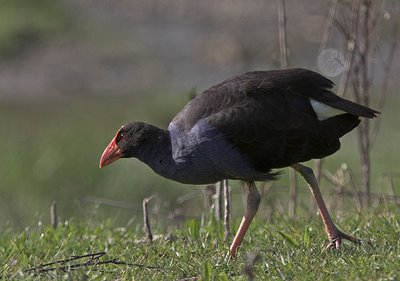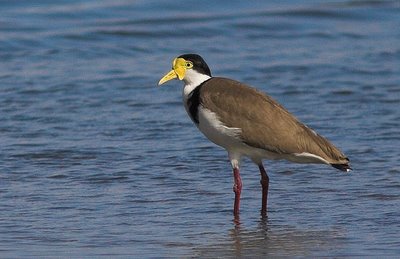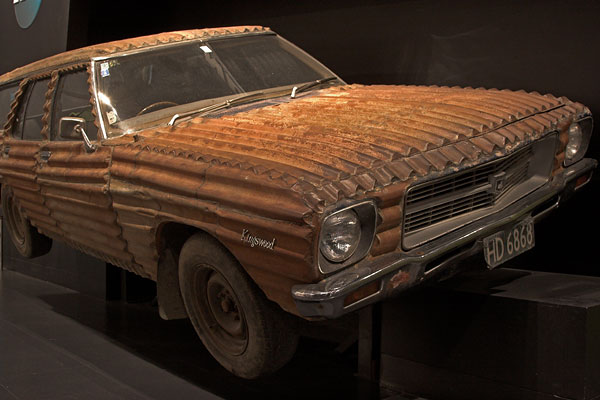 from demolitions and nailed onto the side of a shed to replace the iron rotted by age and too much rain and damp seeping from cold ground. It’s everywhere, from every angle you choose to view the landscape; it’s rural and urban; you find it on old huts in remote areas among mountains and along coasts—particularly along coasts where people shelter after a day’s whitebaiting [1] or surfcasting and drink beer and whisky and lie about what they had on the line. The rain arrives—hard, West Coast rain so loud you can hardly hear the lies so you sit back and eat fritters and enjoy the sound and hope it’ll be a good day in the morning.
from demolitions and nailed onto the side of a shed to replace the iron rotted by age and too much rain and damp seeping from cold ground. It’s everywhere, from every angle you choose to view the landscape; it’s rural and urban; you find it on old huts in remote areas among mountains and along coasts—particularly along coasts where people shelter after a day’s whitebaiting [1] or surfcasting and drink beer and whisky and lie about what they had on the line. The rain arrives—hard, West Coast rain so loud you can hardly hear the lies so you sit back and eat fritters and enjoy the sound and hope it’ll be a good day in the morning. Not everyone appreciates corrugated iron. Some people associate it with other things. Years ago I knew someone who emigrated from South Africa to New Zealand to practise as a GP for the foreseeable future. As her plane flew low over Palmerston North she looked down on the rooftops. She looked down on all those corrugated iron rooftops and burst into tears. She thought she'd come to live in a shanty town.
At Te Papa, the Museum of New Zealand, there’s a Holden Kingswood station wagon on display [2]. The panel work is made from corrugated iron the colour of rust. To me, cars are tools, but I can appreciate a car like that.
I think it’s the texture I love as much as anything else. A corrugated iron wall can never be a blank wall. Not like the freshly painted wall I see out this window, across the street from the Wellington City Library, next to the construction site. A blank, concrete wall, painted khaki. Bland and featureless, it functions aesthetically only as a screen on which the late morning sun projects patterns of shadow and  light from the glass and concrete surroundings, and as a backdrop for the found sculpture of reinforcing rods projecting skywards from the foundations like stripped sinews. Corrugated iron, however, always has texture; it’s never blank. Lead-head nails slide their shadows across the corrugations; the sun glances off the side of a shed at a low angle and every long hollow’s a line of shadow, every ridge a bright line of light. The pattern's so regular that every dent stands out, each containing a story. A world without imperfections is a world with nothing to say.
light from the glass and concrete surroundings, and as a backdrop for the found sculpture of reinforcing rods projecting skywards from the foundations like stripped sinews. Corrugated iron, however, always has texture; it’s never blank. Lead-head nails slide their shadows across the corrugations; the sun glances off the side of a shed at a low angle and every long hollow’s a line of shadow, every ridge a bright line of light. The pattern's so regular that every dent stands out, each containing a story. A world without imperfections is a world with nothing to say.
I drive the narrow road to Kuku beach, past dairy farms and ragged hedges, by old wire fences with battens leaning at random angles. The wire's still the old, pliable No. 8, not the thin and difficult high tensile modern stuff. Beyond the railway line there’s a poultry farm, every shed made of corrugated iron. Pukeko [3] forage in roadside paddocks, high stepping, tails flicking. One stretches its neck to inspect the car as I idle past; another slips away, head down, through long, hummocky grass. More reptile, or dinosaur, than bird. Each house has one or more sheds or garages of corrugated iron; the houses themselves are roofed with it. Haybarns, milking sheds, calf shelters, abandoned fowlhouses—all corrugated iron in shades of oxidised galvanising and faded red. That battered shed over there might once have been pale lavender, perhaps from a cheap lot of bargain bin paint; now it’s almost indistinguishable from the grey of aged iron. A shelter by a farm driveway is the simplest of structures: three sides and a roof, just enough in which to keep dry until the school bus arrives; a basic frame of weathered four by twos and a few sheets of corrugated iron banged on with left-over lead-heads. But the bus has gone, the kids have disappeared, and the shelter contains nothing but sunlight and shadows, the warmth of Spring and a few infinitely patient spiders  at the mouths of their retreats. Nail a sheet of corrugated iron to a wooden frame and you create 27 homes [4].
at the mouths of their retreats. Nail a sheet of corrugated iron to a wooden frame and you create 27 homes [4].
The car bounces over the last 50 metres of sandy track to the carpark. I assume this is it; it’s just a flattish area in the dunes, near a line of low, salt-stunted macrocarpas. Empty of cars, empty of people. The place has that out-of-time feel, as if it’s been abandoned by the twenty-first century, left to the birds and the wind. I walk slowly, aware how each footprint adds to the line, and sit on a driftwood log in the sun and the cold breeze. A spur winged plover [5] calls at me until it sees I’m sitting still, then it resumes its inspection of the shallow water along the edge of the stream. On the far side, pied stilts [6] step and yelp and probe the water.
The whitebaiters padlock the door and drive off, and a blowfly, trapped inside, walks up and down the windowsill; a cloud passes overhead and the iron roof cools and contracts, banging and cracking. Inside, the clock's tick stops; the fly pauses, then falls to the floor, and the room fills with the sound of surf at the river's mouth and wind around the walls.

Notes:
1. New Zealand whitebait are juvenile forms of our native galaxiid fishes. They're mostly diadromous and definitely delicious, with inanga (Galaxias maculatus; considered catadromous because the adults migrate to estuaries to spawn) reputedly being the best of the several main species of whitebait. In Wellington last week, 100 gram punnets of whitebait were selling for NZ$15; bad luck if you're short of money—or if you're a whitebait.
2. The work is by Jeff Thomson (do check out the link; it's an excellent essay with great examples of his work). He's well known for his corrugated iron sculptures, particularly the animals.
3. Porphyrio porphyrio. The English vernacular is “swamphen”, but no one I know calls them that in New Zealand. They're always pukeko. Or “pookackas”, sometimes abbreviated to “pooks”. A few farmers—those whose crops have been damaged or water troughs fouled—have other names for them.
4. Three rows of nine tunnels. Now, corrugated iron is rolled in all sorts of lengths and contours, but my calculation's roughly true for the old style sheets. Its propensity for harbouring little creatures is something else people hate about it. Understandable when you're sitting on the long drop at night, surrounded by the gleam of spiders' eyes, the long legs of Cambridgea reaching out from between the iron and wood.
5. Vanellus miles novaehollandiae. Rare only a few decades ago, these weird and rowdy birds have spread throughout New Zealand and are now among the most common farmland birds. Because they prefer large areas of open pasture, they're found at most airports; consequently, they're the most common cause of bird strikes in New Zealand.
6. Poaka; Himantopus himantopus.
Photos (click on those above if you want a larger image):
1. Shed and creeper; Shannon.
2. Pukeko at Lindale; Horowhenua.
3. Spur winged plover at Kuku beach; Horowhenua.
4. Jeff Thomson's Holden; Te Papa, Wellington.
Photos and words © 2006 Pete McGregor
23 comments:
Hi Pete,
...the Icelanders belive that they have been the first ones to use corrugated iron for their houses...
what ever...
...but the Kiwis are probably the first ones to use it for car.
Years ago my wife and I saw three framed pieces of rusted corrugated iron hanging in the National Gallery in Canberra. Another exhibit was a pile of bricks in a corner. Coming from the building game, I mused on all the riches I'd sent to the tip.
I just used it for the first time last fall, to roof a small structure. I liked working with it, and I like the look. Thanks for this in-depth look at the material (which I guess we call "corrugated steel" here in the States).
This inspired me to go look up some photos from last year. Here's one of them.
Reading you wax poetically about corrugated steel almosts makes me wish I'd covered the House in it Pete. Almost.
I have to admit though that at the end of the day it is the texture, feel and colour of wood that might make me feel this way.
blur your eyes and it's cardboard.
or wavy gravy
One of the best sounds in the world.......listening to the rain on a corrugated iron roof as you drift off to sleep!
Great words P. And ditto links.
The stuff is ever present here in Oz too. Indeed, have just bought some new. Sparkling silver grey.....just doesn't look right. Will use it and wait for the weather to work on it.
Huge thanks for that spider image in the dunny...you made my morning! Eeergh!
Will: Hmmm... you've made me think. I wonder if there's a market for corrugated iron computers? With No. 8 wire cables?
Duncan: Hah! But think of all the works of art you created. Building's not just a craft. In fact, I think there's a lot to be said for dismissing the “craft vs art” distinction and accepting that a thing well made — made with “right mind” — can have as much quality as an excellent painting or sculpture (like an artfully arranged pile of bricks).
Dave: It's not the sort of stuff you want to be working with when it's windy, though. Roofing is probably its major use here, but many architects (as well as some artists) share your feelings about the look and use it for more than just roofs. Sometimes it works; sometimes it doesn't, and it tends to polarise attitudes.
Clare: Agreed. There's a kind of intimacy and comfort about wood. Warmth, too — both literal and psychological. That's a feeling iron will always struggle to confer.
Sylph: Well, I can manage lumpy gravy with not too much difficulty, but wavy...? I'm impressed. Good point about the corrugated cardboard — I'd forgotten that until you pointed it out. Still, I'm glad my place isn't roofed with it. ;^)
HHnB: I bet it speeded things up. ;^)
Hi Pete,
…well, this – particular this – wouldn’t work. Iceland has one of the advanced internet connections in the world. Extremely fast –if you are somewhere on a farm it takes a little bit longer- , cheap and in a lot cafes, restaurants and bars in Reykjavik and around you have free wireless connection with your laptop.
On the other hand I’ve never been in a country before where the people are so on to status-symbols like on this island. So if you set up the right marketing strategy and let them believe that everybody should have something like this, well it might work, as long as you sell it for expensive enough and as a piece of art.
What a great essay on an unlikely subject, Pete. I, too, was very taken by the corrugated car in Te Papa when we visited NZ.
I regularly cycle across the flat, sometime bleak, expanse of Romney Marsh in S.E. Uk. There is the skeleton of a large iron girder barn, with just one sheet of the stuff left flapping - when the wind blows across those flats you can hear it banging for miles. It is so "part of the landscape" that it is almost an art form - I guess that's why the farmer leaves it there.
Will: Maybe I'm onto something, then? As you suggest, the key might be to sell my kiwi-enhanced computer for an exorbitant price. Unfortunately, Jeff Thomson would probably sue me for stealing his idea.
Thanks Avus. Steel girders, supporting the sky... I suppose some might argue the sound of the iron banging is a form of aural art, but I'd probably struggle with that.
Never thought much about corrugated iron, but seen through your eyes, it's a wonder.
You quoted a verse on "New Gold Dream" blog, Pete
Started "But neither fret nor worried get".
Do you know the origin please?
Patry: Thanks! I hope what I've written will encourage others not just to look at corrugated iron, but to see it. So many people only view it as utilitarian or worse. Perhaps, even if those people don't accept my view, they might at least understand it; in other words, maybe it's a useful exercise in pluralism? ;^)
Avus: Hah! The origin is me — but with the primary credit to KP, for the original verse. My contribution was intended as an encouraging stanza in response to his. I noticed the interesting structure of his stanzas and put together a few lines with the same pattern.
Corrugated iron, barbed wire, chicken mesh, rusting h-beams, railroad tracks, pickaxe heads, and tangled rebar... put them all together and you have quite a bristly landscape. I love nothing more than to see the rust eating away at our monuments and dandelions sprouting between the cracks. What's so distinctive is how often such places have reverted to a tranquility.
That car photo reminded me on one afternoon in New York rounding a corner and stopping face-to-fender in front of a Buick covered in bricks. I've always wondered at the gas mileage and the momentum!
Butuki: Interesting that you should mention rust. The usual connotations are negative, but I love the colours and textures. Last week I was talking with a friend and she mentioned, unprompted, how she loved the colour of rust stains on buildings. The synchronicity of her comment silenced me (briefly!) — I'd written about exactly that, recently.
A poet as well, Pete! We obviously have not completley plumbed your depths yet!
Loved the Buddhist reference in the stanza - a similar outlook to life as Shakespeare's "There is nothing either good or bad, but thinking makes it so". (Hamlet). The Taoist work "Tao te Ching" has similar thoughts and it ain't a bad way to look at life.
Pete
re stanza - brilliantly done - ta
Pete
Corrugated iron is not so heavily used here in uk. Can't understand why. When my roof needed replacing, I thought about using this as a cheap way of reroofing, but it is not in keeping with the rest of the houses. So I had to fork out £6,000.00 on concerete tiles.
As usual, a wonderful essay about the most unlikely subject that makes one stop and think.
Thanks
I enjoyed looking through your eyes.
Avus: Thanks for the Hamlet quote — very pertinent. The Tao Te Ching contains some wonderful ideas: the sorts of things that more than repay the effort needed to think about them.
Thanks K-P. Ouch! Think how much travelling you could do for the cost of that roof. No, wait, on second thought, don't think about it. ;^)
Thankyou, mb :^) Actually, I had my eyes checked yesterday, and they seem to be working fine. However, some people might disagree when they see some of the photos in the next post (which, all going well, will go up this evening).
Love the Kingswood!!!
Cheers Carolyn. Yes, it appealed to me the very first time I saw it. His other work is marvellous, too.
Post a Comment